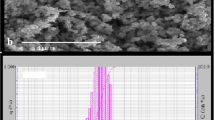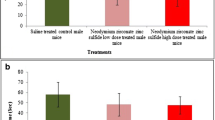Abstract
Lanthanum Zirconate nanoparticles (NPs) are used in blades of gas turbine engines to thermally insulate them and to protect them against hot and corrosive gas streams. However, the information regarding their biocompatibility is limited. The present study was aimed to report the effect of Lanthanum Zirconate NPs on selected aspects of behavior, serum biochemistry, complete blood count and antioxidant parameters from vital organs of albino mice in a gender specific manner. Albino mice, seven weeks old, were orally treated with 75 mg/ml solvent/Kg body weight of Lanthanum Zirconate nanoparticles for consecutive 22 days. Saline treated control groups were maintained in parallel. It was observed that rearing frequency was significantly decreased (P = 0.01) in NPs treated male mice. Complete blood count analysis indicated that NPs treated female mice had significantly reduced white blood cells (P = 0.05) and lymphocytes count (P = 0.03). NPs treated male had significantly reduced serum cholesterol levels (P = 0.05) than control group. It was observed that Superoxide dismutase concentrations in liver (P = 0.025) and kidney (P = 0.008), Malondialdehyde concentrations in liver (P = 0.044) of female and Malondialdehyde concentrations in kidney (P < 0.001) and brain (P < 0.001) and catalase concentrations in liver (P = 0.05) of NPs treated male mice were significantly higher than their respective control groups.. In conclusion, we are reporting that oral supplementation with 75 mg/ml solvent/Kg body weight of Lanthanum Zirconate nanoparticles can affect the behavior, leukocyte count, serum cholesterol and antioxidant metabolites from vital organs of albino mice in a gender specific manner.

Similar content being viewed by others
References
Abdelhalim MAK, Moussa SAA (2012) The dimensional hematological alterations induced in blood of rats in vivo by intraperitoneal administration of gold nanoparticles. J Nanomed Nanotechol 3(4):2157–7439
Allahyar R, Akbar A, Iqbal F (2015) Creatine monohydrate supplementation for 10 weeks mediates neuroprotection and improves learning/memory following neonatal hypoxia ischemia encephalopathy in female albino mice. Brain Res 1595:92–100
Allahyar R, Akbar A, Iqbal F (2017) Effect of creatine monohydrate supplementation on learning, memory and neuromuscular coordination in female albino mice. Acta Neuropsychiat 29(1):27–24
Asharani PV, Mun GK, Hande MP, Valiyaveettil S (2009) Cytotoxicity and genotoxicity of silver nanoparticles in human cells. ACS Nano 3:279–290
Behbehani GR, Divsalar A, Saboury AA, Faridbod F, Ganjali MR (2010) A thermodynamic study on the binding of human serum albumin with lanthanum ion. Chin J Chem 28(2):159–163
Blake DR, Allen RE, Lunec J (1987) Free radicals in biological systems—a review orientated to inflammatory processes. Br Med Bull 43:371–385
Blokhina O, Virolainen E, Fagerstedt KV (2003) Antioxidants, oxidative damage and oxygen deprivation stress: a review. Ann Bot 91(2):179–194
Briner W, Rycek RF, Moellenberndt A, Dannull K (2000) Neurodevelopmental effects of lanthnum in mice. J Neurotoxicol Teratol 22:573–581
Cao XQ, Vassen R, Fischer W, Tietz F, Jungen W, Stoever D (2003) Lanthanum–cerium oxide as a thermal barrier-coating material for high-temperature applications. Adv Mater 15(17):1438–1442
Cejas P, Casado E, Belda-Iniesta C, De Castro J, Espinosa E, Redondo A, Perona R (2004) Implications of oxidative stress and cell membrane lipid peroxidation in human cancer (Spain). Cancer Causes Control 15(7):707–719
Chidambara MKN, Jayaprakasha GK, Singh RP (2002) Studies on antioxidant activity of pomegranate (Punica granatum) peel extract using in vivo models. J Agric Food Chem 50:4791–4479
Del Rio D, Stewart AJ, Pellegrini N (2005) A review of recent studies on malondialdehyde as toxic molecule and biological marker of oxidative stress. Nutrit Met Cardiovas Dis 15(4):316–328
Derks NAV, Krugers HJ, Hoogenraad CC, Joëls M, Sarabdjitsingh RS (2017) Effects of early life stress on rodent hippocampal synaptic plasticity: a systematic review. Curr Opin Behav Sci 14:155–166
Farid MA, Asghar MA, Ashiq MN, Ehsan MF, Athar M (2014) Hydrothermal synthesis of doped Lanthanum Zirconate nanomaterials and the effect of V-Ge substitution on their structural, electrical and dielectric properties. Mater Res Bull 59:405–410
Gaharwar US, Paulraj R (2015) Iron oxide nanoparticles induced oxidative damage in peripheral blood cells of rat. J Biomed Sci Eng 8:274–286
Haider S, Naqvi F, Batool Z, Tabassum S, Sadir S, Liaquat L, Perveen T (2015) Pretreatment with curcumin attenuates anxiety while strengthens memory performance after one short stress experience in male rats. Brain Res Bull 115:1–8
Hu R, Gong X, Duan Y, Li N, Che Y, Cui Y, Zhou M, Liu C, Wang H, Hong F (2010) Neurotoxicological effects and the impairement of spatial recognition memory in mice caused by exposure to TiO2 nanoparticles. J Biomat 31:8043–8050
Iqbal S, Ali M, Iqbal F (2015) Long term creatine monohydrate supplementation, following neonatal hypoxic ischemic insult, improves neuromuscular coordination and spatial learning in male albino mouse. Brain Res 1603:76–83
Iqbal F, Hoeger H, Lubec G, Bodamer O (2017) Biochemical and behavioral phenotype of AGAT and GAMT deficient mice following long-term Creatine monohydrate supplementation. Metab Brain Dis 32(6):1951–1961
Jin C, Tang Y, Yang FG, Li XL, Xu S, Fan XY, Huang YY, Yang YJ (2011) Cellular toxicity of TiO2 nanoparticles in anatase and rutile crystal phase. Biol Trace Elem Res 141:3–15
Lateef T, Qureshi SA (2013) Centratherum anthelminticum ameliorates antiatherogenic index in hyperlipidemic rabbit. Int J Pharm 3:698–704
Lever C, Burton S, O keefe J (2006) Rearing on hind legs, environmental novelty, and the hippocampal formation. Rev Neurosci 17(1–2):111–133
Li N, Sioutas C, Cho A, Schmitz D, Misra C, Sempf J, Nel A (2003) Ultrafine particulate pollutants induce oxidative stress and mitochondrial damage. Environ Health Perspect 111:455–459
Liu Z, Kiessling F, Gatjens J (2010) Advanced nanomaterials in multimodal imaging: design, functionalization, and biomedical applications. J Nanomet 2010:1–15. https://doi.org/10.1155/2010/894303
Matés JM, Pérez-Gómez C, De Castro IN (1999) Antioxidant enzymes and human diseases. Clin Biochem 32(8):595–603
Nel A, Xia T, Madler L, Lin N (2006) Toxic potential of materials at the nano level. Science 311:622–627
Oberdorster G, Oberdorster E, Oberdorster J (2005) Nanotoxicology: an emerging discipline evolving from studies of ultrafine particles. Environ Health Perspect 113:823–839
Pasupuleti S, Alapati S, Ganapathy S, Anumolu G, Pully NR, Prakhya BMT (2012) Toxicity of zinc oxide nanoparticles through oral route. Toxicol Ind Health 28(8):675–686
Samson AL, Lining J, Kim A, Zhang H, Shenpeng R, Jessica AA, Sharelle A, Christopher G, Shaun P, Simone M (2015) MouseMove: an open source program for semi-automated analysis of movement and cognitive testing in rodents. Sci Rep 5:16171. https://doi.org/10.1038/srep16171
Shohami E, Beit-Yannai E, Horowitz M, Kohen R (1997) Oxidative stress in closed-head injury: brain antioxidant capacity as an indicator of functional outcome. J Cereb Blood Flow Metab 17:1007–1019
Simko M, Mattsson MO (2010) Risks from accidental exposures to engineered nanoparticles and neurological health effects: a critical review. Part Fib Toxicol 7:42
Wan R, Mo Y, Feng L, Chien S, Tollerud DJ, Zhang Q (2012) DNA damage caused by metal nanoparticles: involvement of oxidative stress and activation of ATM. Chem Res Toxicol 25:1402–1411
Wang TC, He X, Zhang ZY, Jia G, Wang X (2006) Effects on serum glucose and lipids in chronic exposure to lanthanum chloride in rat. Zhonghua Yu Fang Yi Xue Za Zhi. Europe PMCorg
Wang H, Wick RL, Xing B (2009) Toxicity of nanoparticulate and bulk ZnO, Al2O3 and TiO2 to the nematode Caenorhabditis elegans. Environ Pollut 157:1171–1177
Weber SB, Lein HL, Grande T, Einarsrud MA (2013) Lanthanum Zirconate thermal barrier coatings deposited by spray pyrolysis. Surf Coat Technol 227:10–14
Yongxing W, Xiaorong W, Zichun H (2000) Genotoxicity of lanthanum (III) and gadolinium (III) in human peripheral blood lymphocytes. Bull Environ Contam Toxicol 64(4):611–616
Zahra K, Khan M, Iqbal F (2015) Oral supplementation of Ocimum basilicum has the potential to improves the locomotory, exploratory, anxiolytic behavior and learning in adult male albino mice. Neurol Sci 36:73–78
Zeng H (2008) Synthesis, properties and potential applications of multicomponent magnetic nanoparticles. Ad Funct Mat 18:391–400
Zhang J, Guo X, Jung YG, Li L, Knapp J (2016) Lanthanum Zirconate based thermal barrier coatings. Surf Coat Technol. https://doi.org/10.1016/j.surfcoat.2016.10.019 S0257-8972(16)31013-1
Author information
Authors and Affiliations
Corresponding author
Ethics declarations
Conflict of interest
Authors declare that they do not have conflict of interest of any sort with anyone.
Electronic supplementary material
Supplementary Fig. 1
Comparison of Rota rod test results between saline treated control and albino mice treated with 75 mg/ml solvent/Kg body weight of Lanthanum Zirconate nanoparticles for 22 days. N = 10 for each treatment. All values are expressed as mean ± slandered error of mean. P-value represents the results of 2 sample t-test. (JPG 56 kb)
Supplementary Fig 2
Comparison of gain in body weight for 22 days on daily basis between Lanthnum Zirconate nanoparticles treated (75 mg/ml of solvent/Kg body weight) and untreated adult albino mice of both genders. N = 10 for each treatment. Data is expressed as mean ± standard error of mean. P > 0.05 = Non significant for all each day (2 sample t test) (JPG 57 kb)
Supplementary Table 1
(DOCX 12 kb)
Rights and permissions
About this article
Cite this article
Aftab, M.N., Akram, I.N., Khosa, T. et al. Oral supplementation of Lanthanum Zirconate nanoparticles moderately affected behavior but drastically disturbed leukocyte count, serum cholesterol levels and antioxidant parameters from vital organs of albino mice in a gender specific manner. Metab Brain Dis 33, 1421–1429 (2018). https://doi.org/10.1007/s11011-018-0248-9
Received:
Accepted:
Published:
Issue Date:
DOI: https://doi.org/10.1007/s11011-018-0248-9




